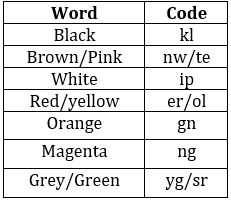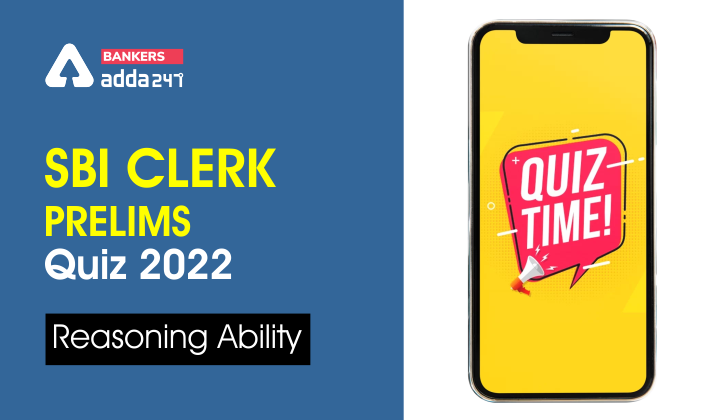Directions (1-5): Study the information carefully and answer the questions given below.
In a certain code language,
‘Black Brown White Pink’ is written as ‘kl nw te ip’,
‘White Red Yellow Orange’ is written as ‘ip er ol gn’,
‘Orange Brown Magenta Pink’ is written as ‘gn nw ng te’
‘Grey Black Orange Green’ is written as ‘yg kl sr gn’.
Q1. What may be the code for ‘Grey magenta’ in the given code language?
(a) nw ip
(b) er sr
(c) sr ip
(d) yg ng
(e) None of these
Q2. What is the code for ‘White’ in the given code language?
(a) ip
(b) nw
(c) kl
(d) er
(e) None of these
Q3. What is the code for ‘Brown’ in the given code language?
(a) nw
(b) ip
(c) te
(d) ng
(e) Can’t be determined
Q4. What is the word for ‘gn’ in the given code language?
(a) Pink
(b) Blue
(c) Orange
(d) Green
(e) None of these
Q5. What may be the code for ‘Red Orange Green’?
(a) nw yg ip
(b) ol gn kl
(c) gn ip ol
(d) er gn sr
(e) yg gn ip
Directions (6-10): In these questions, relationship between different elements is show in the statements. The statements are followed by conclusions. Study the conclusions based on the given statements and select the appropriate answer:
(a) If only conclusion I follows.
(b) If only conclusion II follows.
(c) If either conclusion I or II follows
(d) If neither conclusion I nor II follows.
(e) If both conclusions I and II follow.
Q6. Statements: Q>H≤D≥G>S=B≤L=I<Z
Conclusion: I: S<Z
II: D≥B
Q7. Statements: H=B≤C≤N>M=X≥P=L>D
Conclusion: I: H<N
II: M≥ L
Q8. Statements: C>B<O<P=L>H=M≥S>X
Conclusion: I: O>S
II: S≤O
Q9. Statements: X>T<Y<B≥C>M=O≥P>Q
Conclusion: I: T<C
II: Q<M
Q10. Statements: S>W=N≤X≤K=J>C≥V
Conclusion: I: W=K
II: W<J
Directions (11-15): In this question, relationship between different elements is shown in the statements. The statements are followed by conclusions. Study the conclusions based on the given statement and select the appropriate answer.
(a) If only conclusion I follows.
(b) If only conclusion II follows.
(c) If either conclusion I or II follows
(d) If neither conclusion I nor II follows.
(e) If both conclusions I and II follow.
Q11. Statements: P>Q>R=U, U≥T<S, T≥W
Conclusions: I. R>W
II. U=W
Q12. Statements: P>Q>R<U, U≥V>S, V<W
Conclusions: I. P>S
II. P<S
Q13. Statements: A=K>X<L>N≤R, Q≥A, N=M
Conclusions: I. Q>X
II. K>M
Q14. Statements: J=K>X<L>N≤R; Q≥K; J<M
Conclusions: I. Q>X
II. X<M
Q15. Statements: J>K>X<L>N≤R; Q≥J<M
Conclusions: I. R<M
II. M≥R
Solutions
Solution (1-5):
Sol.

S1. Ans. (d)
S2. Ans. (a)
S3. Ans. (e)
S4. Ans. (c)
S5. Ans. (d)
S6. Ans. (a)
Sol. I: S<Z (True)
II: D≥B(False)
S7. Ans. (b)
Sol. I: H<N (False)
II: M≥ L(True)
S8. Ans. (d)
Sol. I: O>S (False)
II: S≤O(False)
S9. Ans. (b)
Sol. I: T<C(False)
II: Q<M(True)
S10. Ans. (c)
Sol. I: W=K(False)
II: W<J(False)
S11. Ans. (c)
Sol. I. R > W (False)
II. U = W (False)
S12. Ans. (d)
Sol. I. P > S (False)
II. P < S (False)
S13. Ans. (a)
Sol. I. Q > X (True)
II. K > M (False)
S14. Ans. (e)
Sol. I. Q > X (True)
II. X < M (True)
S15. Ans. (d)
Sol. I. R < M (False)
II. M ≥ R (False)





 GA Capsule for SBI Clerk Mains 2025, Dow...
GA Capsule for SBI Clerk Mains 2025, Dow...
 The Hindu Review October 2022: Download ...
The Hindu Review October 2022: Download ...
 IBPS Clerk Mains Cut Off 2025, Check Sta...
IBPS Clerk Mains Cut Off 2025, Check Sta...







